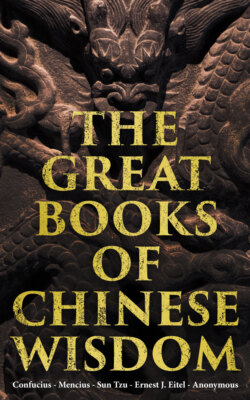Читать книгу The Great Books of Chinese Wisdom - Mencius - Страница 33
ОглавлениеHexagram XVII.17 Sui
Sui indicates that (under its conditions) there will be great progress and success. But it will be advantageous to be firm and correct. There will (then) be no error.
1. The first line, undivided, shows us one changing the object of his pursuit; but if he be firm and correct, there will he good fortune. Going beyond (his own) gate to find associates, he will achieve merit.
2. The second line, divided, shows us one who cleaves to the little boy, and lets go the man of age and experience.
3. The third line, divided, shows us one who cleaves to the man of age and experience, and lets go. the little boy. Such following will get what it seeks; but it will be advantageous to adhere to what is firm and correct.
4. The fourth line, undivided, shows us one followed and obtaining (adherents). Though he be firm and correct, there will be evil. If he be sincere (however) in his course, and make that evident, into what error will he fall?
5. The fifth line, undivided, shows us (the ruler) sincere in (fostering all) that is excellent. There will be good fortune.
6. The topmost line, divided, shows us (that sincerity) firmly held and clung to, yea, and bound fast. (We see) the king with it presenting his offerings on the western mountain.
Footnotes
17. Sui symbolises the idea of following. It is said to follow Yü, the symbol of harmony and satisfaction. Where there are these conditions men are sure to follow; nor will they follow those in whom they have no complacency. The hexagram includes the cases where one follows others, and where others follow him; and the auspice of great progress and success is due to this flexibility and applicability of it. But in both cases the following must be guided by a reference to what is proper and correct. See the notes on the Thwan and the Great Symbolism.
Line 1 is strong, and lord of the lower trigram. The weak lines ought to follow it; but here it is below them, in the lowest place of the figure. This gives rise to the representation of one changing his pursuit. Still through the native vigour indicated by the line being strong, and in its correct place, its subject will be fortunate. Going beyond his gate to find associates indicates his public spirit, and superiority to selfish considerations.
Line 2 is weak. Its proper correlate is the strong 5; but it prefers to cleave to the line below, instead of waiting to follow 5. Hence the symbolism of the text, the bad omen of which needs not to be mentioned.
Line 3 is also weak, but it follows the strong line above it and leaves line 1, reversing the course of 2;--with a different issue. It is weak, however, and 4 is not its proper correlate; hence the conclusion of the paragraph is equivalent to a caution.
Line 4 is strong, and in the place of a great minister next the ruler in 5. But his having adherents may be injurious to the supreme and sole authority of that ruler, and only a sincere loyalty will save him from. error and misfortune.
Line 5 is strong, and in its correct place, with 2 as its proper correlate; thus producing the auspicious symbolism.
The issue of the hexagram is seen in line 6; which represents the ideal of following, directed by the most sincere adherence to p. 95 what is right. This influence not only extends to men, but also to spiritual beings. 'The western hill' is mount Khî, at the foot of which was the original settlement of the house of Kâu, in B. C. 1325. The use of the name 'king' here brings us down from Wăn into the time of king Wû at least.
